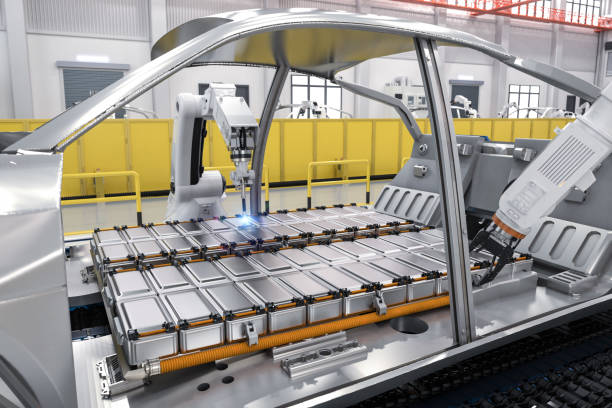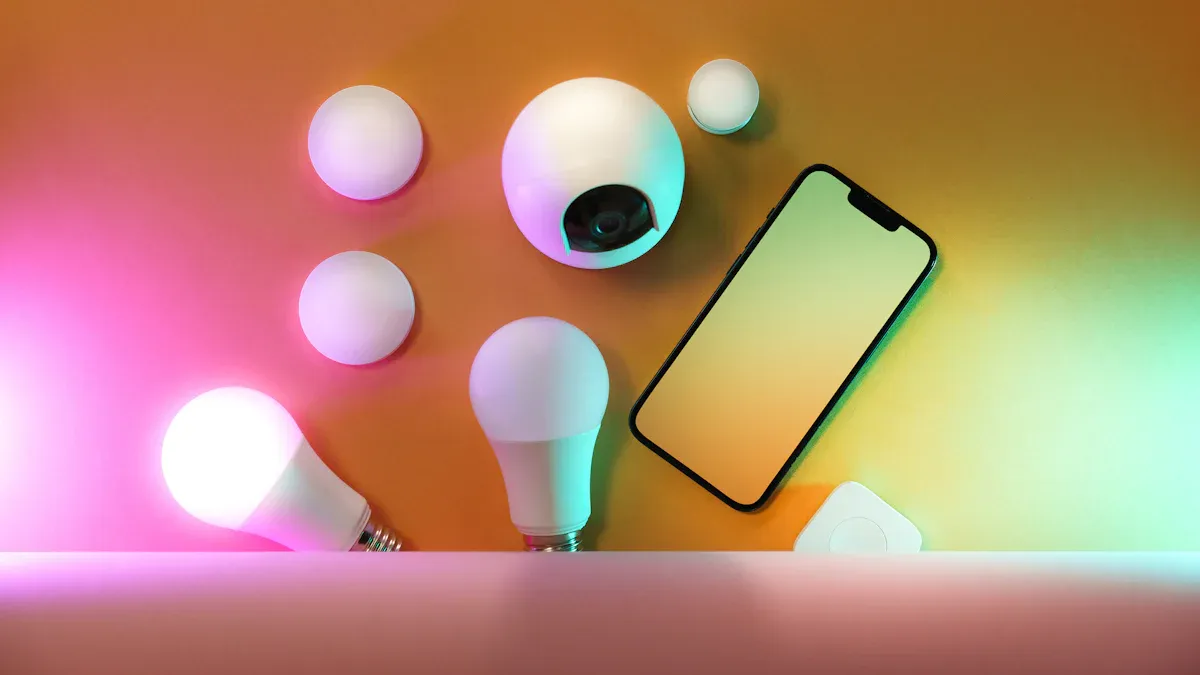How Battery-Powered Devices Are Transforming Home and Workspaces

Battery-powered devices have transformed how we live and work, making tasks easier and more convenient for daily use. In 2023, the global home battery supply market was valued at $14.86 billion, and by 2032, it is projected to grow to $61.33 billion. This trend indicates our increasing reliance on portable power solutions. Lithium-ion batteries, known for their ability to store significant amounts of energy and their longevity, enable smaller designs for various applications. Additionally, they contribute positively to the environment, aligning with our green goals. These advancements highlight how innovative battery-powered technologies are paving the way for a smarter, eco-friendly world.
Key Takeaways
Devices with batteries are easy to carry and use anywhere.
They are quiet, perfect for homes and offices, and feel comfortable.
Batteries are better for the environment, cutting pollution and trash.
No cords mean fewer trips and falls, making them safer to use.
Buying battery devices saves money over time with less upkeep.
Key Benefits of Battery-Powered Devices

Portability and flexibility
Battery-powered devices are easy to carry and use anywhere. They don’t need cords, so you can move freely. This helps people work better, especially in places where moving around is important. For example, tools like battery drills and saws let workers do jobs in areas without electricity.
Better batteries make these devices even more useful. Here’s a simple comparison of different battery types:
Feature | Li-ion | Li-Po | LiFePO4 |
|---|---|---|---|
Energy Stored (Wh/kg) | 150-250 | 130-200 | 90-120 |
Lifespan (cycles) | 500-1,500 | 300-500 | 3,000-7,000 |
Heat Range (°C) | 0 to 45 | 0 to 40 | -20 to 60 |
Charge Speed (C) | 0.5-1 | 1-2 | Up to 2 |
This table shows how batteries are strong, last long, and work in many conditions. These features help people set up workspaces that fit their needs.
Reduced noise and user-friendly operation
Battery-powered devices are quiet, making them comfortable to use. Unlike loud gas engines or motors, they make little noise. This makes them great for homes, offices, and quiet places.
Here’s how loud some battery devices are:
Device Type | Noise Level (dB(A)) | Distance (ft) |
|---|---|---|
Refrigerators | 35 - 52 | 3 |
Sewing Machines | 70 - 75 | 3 |
Men's and Women's Shavers | 49 - 69 | 3 |
Electric Toothbrushes | 48 - 55 | 3 |
These low noise levels make using them more enjoyable. Also, their simple designs make them easy to handle. Lightweight builds, comfy grips, and easy controls help everyone, from beginners to experts.
Eco-friendliness and sustainability
Battery-powered devices are better for the planet. They use less fuel and create fewer emissions. Batteries like lithium-ion and LiFePO4 last longer, so there’s less waste.
Studies show we need to check how batteries affect the environment, money, and people. This helps us make better choices for the planet. But, we also need to fix problems between these areas.
Battery devices can be even greener with solar panels. This mix lowers pollution and gives users more control over their energy use.
Safer cordless designs
Cordless tools make homes and workplaces safer. Without cords, there’s less chance of tripping or falling. This also stops kids and pets from getting tangled in wires.
Battery tools built with safety rules are more reliable. For example:
Over 90% of FDA-approved medical devices use safe batteries.
Devices meeting IEC standards have 25% fewer battery problems.
UL2054 standards cut overheating and fire risks by 40% in five years.
These changes show how cordless tools fix safety issues from wired devices.
Studies prove wireless designs are helpful. Pacemakers are smaller and work better without wires. Animal tests show fewer deaths during surgery with wireless tools. Also, wireless designs cost less, making them a smart choice.
Cordless tools are safer where electricity is risky. They don’t need live wires, so shocks are less likely. This makes them great for outdoor or wet areas. Their small size helps in tight spaces without needing a cord.
Applications of Battery-Powered Devices

Tools for Home and Work Use
Battery tools have changed how we work and fix things. They are easy to use and don’t need cords. Homeowners use battery trimmers and blowers to care for their yards. Landscapers also like these tools because they are quiet and portable.
More people are buying battery tools every year. In 2024, over 30 million cordless tools were sold worldwide. Most of these tools used lithium-ion batteries. Construction workers bought over 40 million power tools, making them the biggest users. Over 60% of cordless tools were sold to contractors and tradespeople. Car companies also bought over 15 million tools for repairs and building cars. Smart tools with IoT features sold over 7 million units in 2024.
These tools help people work faster and save energy. Rechargeable batteries mean less waste, which is better for the planet. As technology improves, battery tools will become even better and more useful.
Wireless Devices for Smart Homes
Wireless battery devices are making smart homes better and easier to use. They don’t need wires, so they are simple to set up. Devices like smart thermostats and cameras give homeowners more control.
The market for wireless smart home devices is growing fast. Hardware makes up 54.6% of the market, and wireless systems are 59.3%. This shows people prefer battery-powered devices for their homes. These devices save energy and let users control them with phones or voice assistants.
Smart home tech is improving with longer battery life and better connections. Wireless battery devices are now a key part of eco-friendly and smart homes.
Battery Carts in Healthcare
Battery carts are very helpful in hospitals and clinics. They let doctors and nurses move tools and records easily. This helps them care for patients faster and better.
In 2023, the market for battery carts was worth $1.5 billion. By 2032, it could grow to $3.2 billion, with an 8.6% yearly growth rate. Hospitals want portable and reliable tools, which is why these carts are popular. They also help doctors spend more time with patients.
Battery carts are safe and work even during power outages. Better batteries make them more dependable. As healthcare focuses on better care, more places will use these carts.
Portable appliances for everyday convenience
Portable battery devices are now a big part of homes. They make daily tasks easier and more flexible. These gadgets help with cooking, cleaning, grooming, and even fun activities. Their small size and no-cord design make them perfect for home or travel.
The market for portable battery devices is growing fast. In 2023, it was worth $12.3 billion and may reach $28.5 billion by 2032. This means it could grow by 10.1% every year. Another report says the market could be $1.6 trillion in 2024 and $2.4 trillion by 2030, growing 7.3% yearly. These numbers show more people are using these devices everywhere.
Devices like handheld vacuums, kettles, and fans have changed chores. Handheld vacuums clean tight spaces without cords. Battery fans help during outdoor trips or power cuts. These tools save time and are easier to use than wired ones.
People love portable devices because they work anywhere. Travelers use battery grooming tools and chargers while on trips. Students and workers like desk lamps and wireless speakers for work or fun. These devices meet the need for easy and flexible use.
Eco-friendly features make these devices even better. Many use rechargeable batteries, cutting down on waste. This helps the planet and reduces trash. Better batteries last longer and work more efficiently. This makes portable devices more sustainable over time.
Technological Advancements in Battery-Powered Devices
Innovations in battery efficiency and lifespan
New battery technology makes devices last longer and work better. Scientists at Penn State found a way to study batteries closely. This helps improve how batteries perform and stay durable. At SLAC-Stanford, researchers learned charging lithium-ion batteries fast before use makes them last 50% longer. This method cuts charging time from 10 hours to 20 minutes. Early charging steps are key to better battery life.
Solid-state batteries are safer and store more energy. They are great for emergencies because they work quickly. Scientists are testing new materials like sodium, potassium, and magnesium for better batteries. Lithium-sulfur and lithium-air batteries might store more energy than regular lithium-ion ones.
Integration with renewable energy systems
Batteries now work with solar panels to use clean energy. This setup gives steady power and reduces the need for fuel. It also helps people live in a more eco-friendly way.
Electric cars show how this works well. Smart chargers for cars help balance energy use. These chargers save power, make grids work better, and give backup power during outages. Using renewable energy with smart batteries helps people save energy and protect the planet.
Smart energy management and charging solutions
Smart systems make battery-powered devices work smarter. New designs let batteries charge faster and last longer. Batteries can now adjust to different energy needs. Sensors in batteries give live data to improve energy use.
Machine learning helps manage batteries better. It studies how batteries are used to make them last longer. Old car batteries can be reused for storing energy at home.
Smart chargers are becoming popular. For example, car chargers with V2G tech share energy between cars and grids. These chargers are helpful in emergencies. Smart batteries are now a big part of modern energy systems.
Lightweight and compact designs
Lightweight and small designs have changed battery-powered devices. They are now easier to carry, store, and use daily. Smaller sizes make tools and gadgets more portable and efficient.
Modern batteries have many benefits:
Design flexibility lets them fit in many devices, like phones or medical tools.
Lightweight construction makes them perfect for portable items, like handheld vacuums or smartwatches.
Enhanced safety features prevent overheating or leaks, making them safer to use.
Smaller batteries improve how devices feel and work. Thin batteries fit neatly into gadgets, making them sleek and comfy to hold. Flexible batteries bend to fit curved designs, like foldable phones or watches. Even though they are small, these batteries store lots of energy for long use.
Another great feature is fast recharging. This keeps devices ready to use with less waiting time. These batteries also last through many charges without losing power. Companies use safe, eco-friendly materials to make them better for the planet.
Lightweight and compact batteries are important in today’s tech. They make devices easier to carry, safer, and more eco-friendly. These designs help people everywhere use battery-powered tools more easily and efficiently.
Comparing Battery-Powered Devices with Traditional Alternatives
Cost-effectiveness and long-term savings
Battery devices cost more at first than traditional ones. But, they save money over time. Studies show electric vehicles (EVs) cost less to run and fix. For example:
EVs don’t need gas, cutting regular fuel costs.
Fewer moving parts mean lower repair expenses.
Replacing batteries smartly lowers the total ownership cost.
These reasons help users save a lot of money. Rechargeable batteries in tools last longer, so replacements are rare. This makes them a better choice for homes and businesses. Over time, battery devices are a wise financial decision.
Lower maintenance and ease of use
Traditional devices need regular care, like oil changes or motor fixes. Battery devices need less upkeep because they have fewer parts. For example, cordless tools don’t need fuel or engines, so they’re easier to manage.
Battery devices are also simple to use. They are light and easy to carry. Their controls are user-friendly, and designs are comfy to hold. This makes them great for everyone, no matter their skill level. They also make workspaces cleaner by removing cords and fuel cans.
Enhanced user experience with cordless functionality
Cordless devices change how people use tools and gadgets. No cords mean more freedom and ease. People like cordless appliances for chores because they’re flexible and simple. A recent study shows:
Evidence Description | Key Points |
|---|---|
Cordless appliances are growing popular due to demand | People want easier and more mobile tools for home tasks. |
Better batteries improve how cordless devices work | Consumers like these upgrades in performance and efficiency. |
Energy-saving designs affect buying choices | Companies now make eco-friendly cordless products. |
Users value lightweight tools with long battery life | Demand for portable and long-lasting devices is rising. |
Cordless designs are safer and more fun to use. They remove tripping risks and work well in tight spots. As batteries improve, these devices last longer and work better. This meets the need for portable and efficient tools.
Environmental benefits of battery-powered devices
Battery devices are better for the environment than older tools. They make less pollution when used, helping keep the air clean. For example, electric cars pollute less than gas-powered ones. In places like China, studies show EVs still produce fewer emissions, even with the costs of making their batteries.
The Life Cycle Assessment (LCA) method checks how devices affect the planet. Research shows electric cars are greener than gas cars during their whole life. From making to throwing away, EVs leave a smaller carbon footprint. This makes them a smarter choice for the Earth.
Battery tools and gadgets also help the planet. They don’t need gas, which lowers pollution and saves resources. Devices like cordless mowers and trimmers work without fuel, cutting harmful emissions. Some battery products now work with solar panels, reducing their impact even more.
Recycling batteries makes them even greener. Companies now use materials that can be reused, cutting waste. Old batteries can store energy again instead of being thrown away. This saves resources and keeps trash out of landfills.
Using battery devices helps people and businesses protect the planet. These tools support eco-friendly living and make the world cleaner and healthier. 🌍
Battery-powered devices have changed how we live and work. They are portable, eco-friendly, and easy to use. These features make them important in homes and workplaces today. They not only make life easier but also help the planet by cutting waste and pollution.
The future of battery technology is exciting. New ideas like NanoBolt lithium tungsten batteries and All-Solid-State Batteries (ASSB) allow faster charging and better energy storage. More people are using electric cars, and caring for the environment is growing. This increases the need for better batteries.
Evidence Type | Description |
|---|---|
Growth Projections | By 2020, 10 million EVs were on roads worldwide, with a 4.6% sales rise in 2021. |
Technological Advancements | NanoBolt lithium tungsten and ASSB offer faster charging and better storage. |
Market Drivers | EV use and eco-awareness are pushing battery tech demand higher. |
Using battery-powered devices can make life cleaner and more efficient. As technology improves, these tools will help create a smarter and greener world. 🌱
What are the main benefits of battery-powered devices?
Battery devices are portable, eco-friendly, and easy to use. They don’t need cords, making them safer and more flexible. They are also quieter and need little upkeep, perfect for home or work.
How long do these batteries usually last?
Battery life depends on type and use. Lithium-ion batteries last 500–1,500 cycles. LiFePO4 batteries can last up to 7,000 cycles. Charging and storing them properly helps them last longer.
Are battery-powered devices more costly than regular ones?
At first, battery devices cost more. But they save money later with less upkeep and lower running costs. Rechargeable batteries mean fewer replacements, making them cheaper over time.
Can battery devices work with renewable energy?
Yes, many battery devices work with solar panels. This setup gives clean power, uses less fuel, and helps the planet.
How should I get rid of old batteries?
Take old batteries to recycling centers for safe disposal. Some stores and brands have recycling programs. Don’t throw batteries in the trash to avoid harming the environment.
See Also
Ensuring Quality Electronics Through Advancing Technology Innovations
RV1126 Drives Artificial Intelligence for Robotics Edge Computing
Three Key Methods XCF01SVOG20C Revolutionizes Industrial Automation
ARTESYN NPT42-M: Energizing the Future of Industrial Automation
Implementing STM32F030C8T6 in Smart Home Automation: A Comprehensive Guide
CALL US DIRECTLY
(+86)755-82724686
RM2508,BlockA,JiaheHuaqiangBuilding,ShenNanMiddleRd,Futian District,Shenzhen,518031,CN
www.keepboomingtech.com sales@keepboomingtech.com
